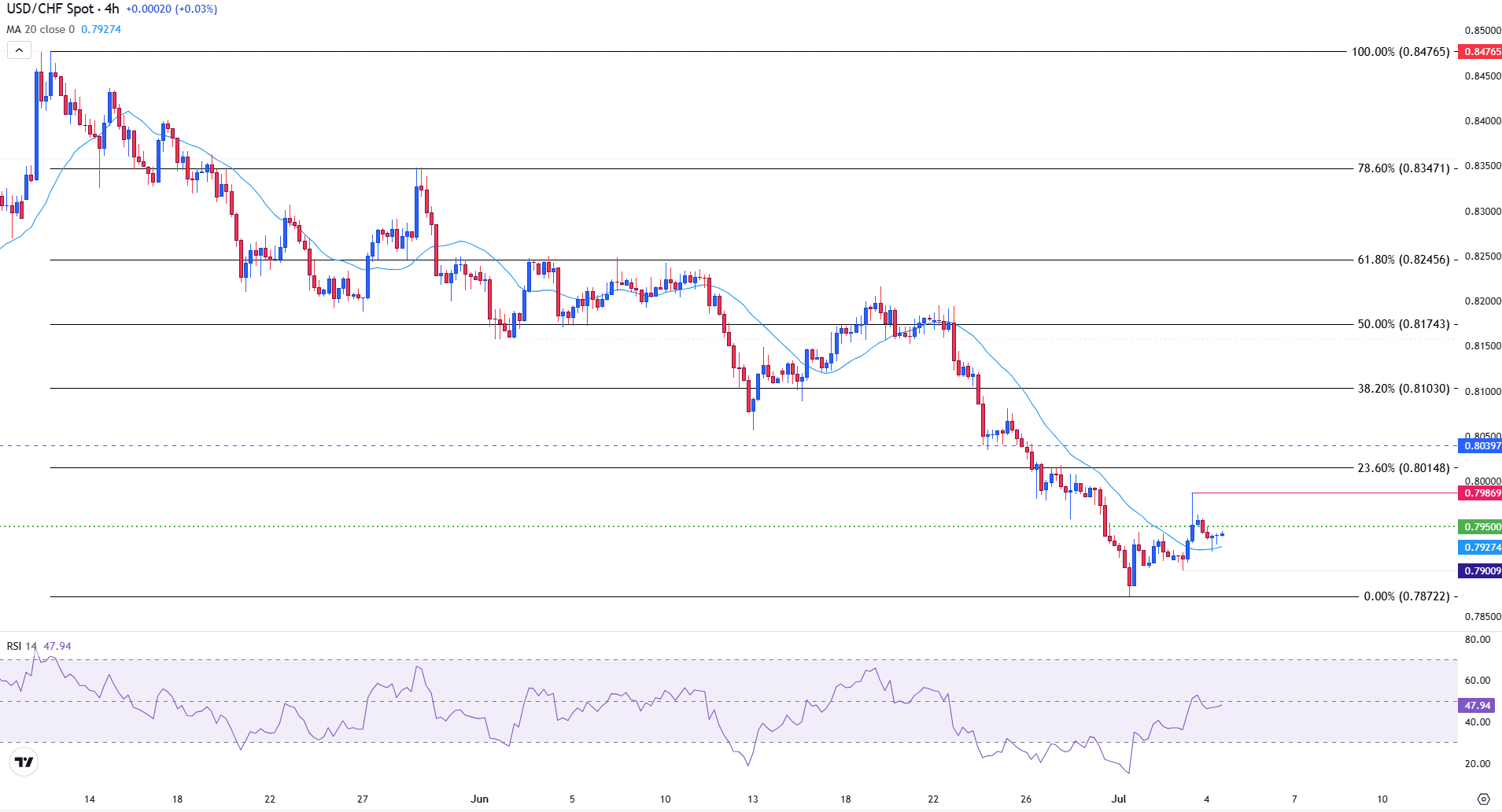Created
: 2025.07.04














![]() 2025.07.04 22:40
2025.07.04 22:40
The Swiss Franc (CHF) is posting modest gains against the US Dollar (USD) on Friday, as renewed fiscal and trade concerns drive demand for safe-haven currencies.
The USD/CHF pair is drifting lower as investors weigh the long-term implications of the newly signed "Big Beautiful Bill" and a looming July 9 tariff deadline that threatens to re-ignite market volatility.
A signing ceremony will be held at the White House on Friday. While President Trump is celebrating the passing of the legislation, the tax and spending bill raises the US debt ceiling by a staggering $5 trillion. Although this helps avert a short-term government funding crisis, it adds significantly to long-term federal borrowing.
According to estimates from the Congressional Budget Office (CBO), the bill is expected to increase the US budget deficit by approximately $3.3 trillion over the next decade, roughly $1 trillion more than the figures provided in the version previously passed in the House.
The mounting deficit and debt burden have weighed on investor sentiment toward the US Dollar.
Increases in government debt raise concerns about long-term fiscal sustainability and inflation risks. This erosion of confidence can lead to selling pressure on the Greenback, particularly against low-yielding safe havens like the Swiss Franc.
Meanwhile, tariff-related tensions are refuelling market jitters. With a July 9 deadline approaching, President Trump has hinted that formal letters outlining new trade terms will be sent to foreign governments as early as today.
Treasury Secretary Scott Bessent failed to soothe markets on Thursday when he declined to confirm whether the administration would postpone the tariff deadline, stating only that "We're going to do what the president wants, and he'll be the one to determine whether they're negotiating in good faith."
This combination of fiscal expansion and trade policy uncertainty could create a supportive backdrop for the Swiss Franc. As a result, USD/CHF remains under modest pressure, with traders cautious ahead of next week's developments on the tariff front and any further clues about the US fiscal trajectory.
The 4-hour chart illustrates a consolidation of USD/CHF price action above 0.7940. The shallow candles reflect indecision in light of the lack of liquidity from the US due to the Independence Day holiday.

While the 20-period Simple Moving Average (SMA) provides near-term support at 0.7927, the 0.7950 psychological level is acting as resistance.
Bears were swift to retaliate after USD/CHF bulls pushed prices to a high of 0.7987 on Thursday, below the next key psychological level of 0.8000.
The Relative Strength Index (RSI) at 48 reflects that momentum on the shorter-duration time frame remains near neutral territory.
On the upside, a move above Thursday's high and a break of 0.8000 could see USD/CHF rising to the 23.6% Fibonacci retracement level of the May-July decline near 0.8015.
Meanwhile, if US Dollar weakness persists, a break below Thursday's low around 0.7900 could see USD/CHF retest Tuesday's multi-year lows around 0.78722.
Tariffs are customs duties levied on certain merchandise imports or a category of products. Tariffs are designed to help local producers and manufacturers be more competitive in the market by providing a price advantage over similar goods that can be imported. Tariffs are widely used as tools of protectionism, along with trade barriers and import quotas.
Although tariffs and taxes both generate government revenue to fund public goods and services, they have several distinctions. Tariffs are prepaid at the port of entry, while taxes are paid at the time of purchase. Taxes are imposed on individual taxpayers and businesses, while tariffs are paid by importers.
There are two schools of thought among economists regarding the usage of tariffs. While some argue that tariffs are necessary to protect domestic industries and address trade imbalances, others see them as a harmful tool that could potentially drive prices higher over the long term and lead to a damaging trade war by encouraging tit-for-tat tariffs.
During the run-up to the presidential election in November 2024, Donald Trump made it clear that he intends to use tariffs to support the US economy and American producers. In 2024, Mexico, China and Canada accounted for 42% of total US imports. In this period, Mexico stood out as the top exporter with $466.6 billion, according to the US Census Bureau. Hence, Trump wants to focus on these three nations when imposing tariffs. He also plans to use the revenue generated through tariffs to lower personal income taxes.
![]()
Created
: 2025.07.04
![]()
Last updated
: 2025.07.04

FXStreet is a forex information website, delivering market analysis and news articles 24/7.
It features a number of articles contributed by well-known analysts, in addition to the ones by its editorial team.
Founded in 2000 by Francesc Riverola, a Spanish economist, it has grown to become a world-renowned information website.
We hope you find this article useful. Any comments or suggestions will be greatly appreciated.
We are also looking for writers with extensive experience in forex and crypto to join us.
please contact us at [email protected].
Disclaimer:
All information and content provided on this website is provided for informational purposes only and is not intended to solicit any investment. Although all efforts are made in order to ensure that the information is correct, no guarantee is provided for the accuracy of any content on this website. Any decision made shall be the responsibility of the investor and Myforex does not take any responsibility whatsoever regarding the use of any information provided herein.
The content provided on this website belongs to Myforex and, where stated, the relevant licensors. All rights are reserved by Myforex and the relevant licensors, and no content of this website, whether in full or in part, shall be copied or displayed elsewhere without the explicit written permission of the relevant copyright holder. If you wish to use any part of the content provided on this website, please ensure that you contact Myforex.
Myforex uses cookies to improve the convenience and functionality of this website. This website may include cookies not only by us but also by third parties (advertisers, log analysts, etc.) for the purpose of tracking the activities of users. Cookie policy